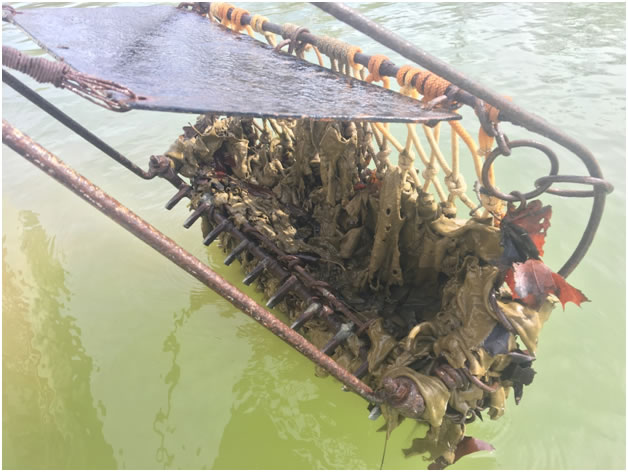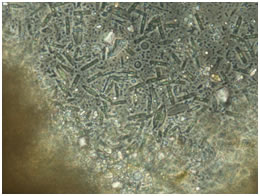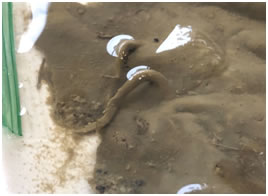| April 2, 2019 Mystery material found in Smith Creek identified |
|

|
|
|
Mystery material from Smith creek in hand dredge. Photo credit: N. Warning, DNR |
|
A strange material was lifted from the bottom of Smith Creek on the Potomac River last week (3/22/19) by Maryland Department of Natural Resources (DNR) fishery biologists. The unusual material was thick (1-2cm), rubbery and covered one half acre of the bottom area being surveyed for potential aquaculture use. The biologists had not previously encountered a material like this and brought a sample back to be analyzed by scientists at the DNR and the Maryland Department of the Environment (MDE). The material was greyish brown to olive green in color, and difficult to tear. When tested, the mat was shown to have characteristics of algae and cyanobacteria. The mystery was solved when the material was examined under a microscope and revealed diatoms (a type of microscopic algae), sediment and debris stuck together in layers. Diatoms are by far the most
common group of sediment algae, giving the sediment a brown color. The material was held together by a sticky substance secreted by some bottom algae, especially diatoms, called extracellular polymeric substances, or EPS, that helps in movement. Diatom mats and microbial films naturally occur on many sediments and rocks in the bay. The size and thickness of this mat suggests a low flow environment. |
|
|
|
 |
|
Close up of material pulled from Smith Creek showing interesting features as part of the substance. Photo: C. Wazniak, DNR |
Microscopic image of the algal mat showing an abundance of pennate diatoms. Photo: C. Luckett, MDE. |
To report fish kills or other algae related issues please contact the Bay Hotline at 1-(877) 224-7229.To track potentially harmful blooms visit the Maryland Department of Natural Resources Harmful Algae interactive map. |
|

